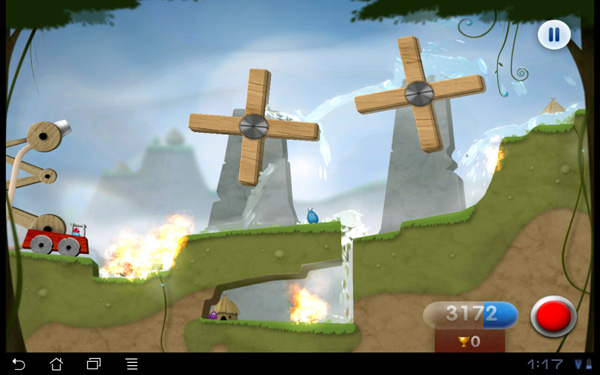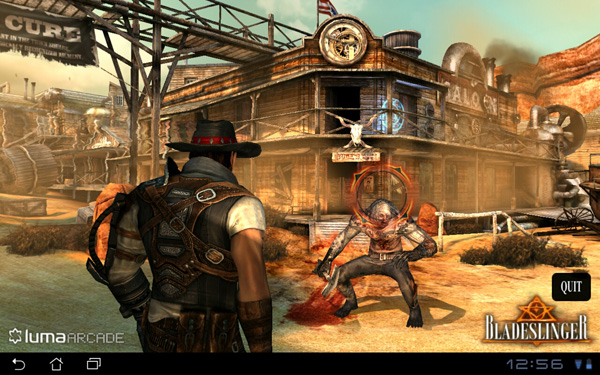ASUS Eee Pad Transformer Prime & NVIDIA Tegra 3 Review
by Anand Lal Shimpi on December 1, 2011 1:00 AM ESTHDMI Output, Controller Compatibility & Gaming Experience
NVIDIA sent along a Logitech Wireless Gamepad F710 with the Eee Pad Transformer Prime to test game controller compatibility. NVIDIA claims the Nintinendo Wiimote, wireless PS3, wired Xbox 360 and various other game controllers will work with Tegra 3 based devices courtesy of NVIDIA's own driver/compatibility work. The Logitech controller worked perfectly, all I had to do was put batteries in the device and plug the USB receiver into the Prime's dock; no other setup was necessary. Note that this same controller actually worked with the original Transformer as well, although there seemed to be some driver/configuration issues that caused unintended inputs there.
By default the Logitech controller navigates the Honeycomb UI just fine. You can use the d-pad to move between icons or home screens, and the start button brings up the apps launcher. The X button acts as a tap/click on an icon (yes, NVIDIA managed to pick a button that's not what Sony or Microsoft use as the accept button - I guess it avoids confusion or adds more confusion depending on who you ask).
Game compatibility with a third party controller is varied. NVIDIA preloaded a ton of Tegra Zone games on the Prime for me to get a good experience of what the platform has to offer. Shadowgun worked just like you'd expect it to, with the two thumbsticks independently controlling movement and aiming. Unfortunately the triggers aren't used in Shadowgun, instead you rely on the A button to fire and the B button to reload. Other games would use the d-pad instead of the thumbsticks for movement or use triggers instead of buttons for main actions. It's not all that different from the console experience, but there did seem to be more variation between control configurations than you'd get compared to what you find on the Xbox 360 or PS3.
The actual gaming experience ranges from meh to pretty fun depending on the title as you might expect. I'd say I had the most fun with Sprinkle and Riptide, with Bladeslinger looking the best (aside from NVIDIA's own Glowball demo).
Sprinkle is a puzzle game that we've written about in the past. You basically roll around with a fire truck putting out fires before they spread and catch huts on fire. It's like a more chill Angry Birds if you're not sick of that comparison. Sprinkle doesn't make use of external controllers, it's touch only.
Riptide is a jetski racing game that does have controller support. There's not a whole lot of depth to the game but it is reminiscent of simple racing games from several years ago. The Tegra version gets an image quality upgrade and overall the game doesn't look too shabby. I probably wasted a little too much time playing this one during the review process. It runs and plays very smoothly on Tegra 3.
Bladeslinger is the best looking title NVIDIA preloaded on the Prime - it's basically a Western themed Infinity Blade knockoff. Image quality and performance are both good, although the tech demo wasn't deep enough to really evaluate the game itself.
For games that support an external controller, the Logitech pad usually just worked. The only exception was Riptide where I had to go in and enable controller support in the settings menu first before I could use the Logitech in game. I don't believe that better third party controller support alone is going to make Android (or the Prime) a true gaming platform, but it's clear this is an avenue that needs continued innovation. NVIDIA wants to turn these tablets and smartphones into a gaming platform, and letting you hook up a wide variety of controllers up to them is a good idea in my book.
HDMI output was easy to enable; I just plugged the Prime into my TV and I got a clone of my display. I didn't have to fiddle with any settings or do anything other than attach a cable. The holy grail? Being able to do this wirelessly. The controller is there, it's time to make it happen with video output as well.












204 Comments
View All Comments
MiSoFine - Thursday, December 1, 2011 - link
my 2 cents...get a Kindle fire. Easier UI for non tech parents & it's still android; cheaper also. Or a Vizio vTab.I got my Mom a Kindle Fire, kids a vTab (they will at least attempt to try to figure it out) & myself a (preordered) Prime.
steven75 - Saturday, December 3, 2011 - link
Considering the complete lack of Android tablet apps, that doesn't seem wise.Enkur - Thursday, December 1, 2011 - link
What is that android app that shows the per core CPU activity in the screenshot above?Lucian Armasu - Thursday, December 1, 2011 - link
Anand, just remember to note, or even test the real world performance when iPad 3 and other high resolution tablets arrive.In your benchmarks they should be showing even faster performance at 720p with the upcoming faster chips, but that might not be the case in the real world. Remember how low FPS the iPhone 4 got with its 4x the resolution over iPhone 3GS, when tested at native resolution?
That should be happening to iPad 3 and the others, too, even if the chips get faster by then. I would wait until at least 2013 to get a 2k resolution tablet, so I won't be that significantly impacted by it.
Lucian Armasu - Thursday, December 1, 2011 - link
Also is there a way to compare the graphics between Tegra 3 and iPad 2 without comparing the benchmark numbers? Like comparing the best graphics on Tegra 3 versus the best one on iPad 2, and notice the differences between them? I really don't think the benchmark numbers tell the whole truth.I think Tegra 3 games may even look/work better than A5 games, thanks to its quad core CPU, too, but I figure you should be able to tell that better than me since you have both.
vision33r - Thursday, December 1, 2011 - link
I disagree, in PC and Console world, the GPU is the determining factor in game graphics and performance.You can take a Core i7 using HD3000 integrated graphics and compare it with a Core i3 with an ATI 4850 and it will spank the Core i7 in gaming performance.
That's what's happening here is the Tegra 3's GPU is underwhelming from a graphics chip maker.
Very few mobile games imo need even dual core, they need the proper graphics acceleration and that's where Android fragmentation has hurt game development.
They have to code games for the lowest common denominator instead of optimizing games for Tegra.
metafor - Thursday, December 1, 2011 - link
That doesn't necessarily translate to the mobile world. On the desktop side, CPU's have gotten so fast that just about any task a game can throw at it -- physics, AI, audio, etc. -- can be done without bottlenecking the game while the shading/rendering on the GPU is still being pushed.On the mobile side, this may not be true (yet) as the CPU's are -- comparatively -- fairly underpowered against their desktop counterparts. Couple this with the fact that the GPU is taxed to push out less pixels and one could easily see situations where the CPU becomes the bottleneck.
As mobile CPU's get faster -- especially with the A15/Krait generation -- this will become less and less of an issue especially as games make use of NEON to do their computationally heavy tasks and we'll get to a point where the GPU is the only bottleneck left.
But I don't see that happening until we hit the ~2.5GHz dual A15/Krait level.
vision33r - Thursday, December 1, 2011 - link
Very few Android games that I've seen are properly optimized unless they got that Optimized for Tegra logo. Otherwise most games do not take advantage of GPU acceleration.On iOS almost all games has some sort of GPU assist. Take Plants vs Zombies, the iOS version is perfect. The Android HD version has lower animation and graphics.
Almost all Gameloft games perform smoother on iOS than on Android.
metafor - Thursday, December 1, 2011 - link
Well yes. But the point is that with a higher performance CPU or group of CPU's, it is possible to have things that would be bottlenecked in a mobile device -- such as physics, AI, etc. -- be more complex and provide better visuals.Whether or not that has been done is another story. But you can hardly blame application devs for pouring more focus into iOS. The iPad is still what, ~90% of the tablet market? Moreover the App Store brings in way more revenue -- which the developers get a cut of -- than Android Market has thus far.
That will hopefully change over time.
steven75 - Saturday, December 3, 2011 - link
The problem with that theory is iPhones still bring in vastly more revenue for developers than android phones, despite the latter having higher market share.